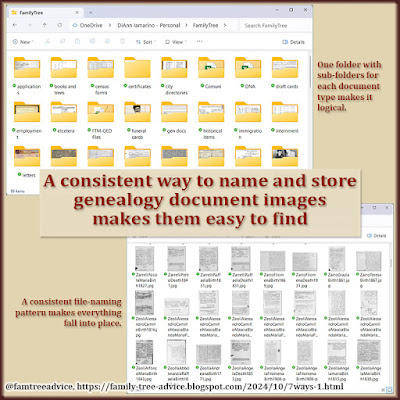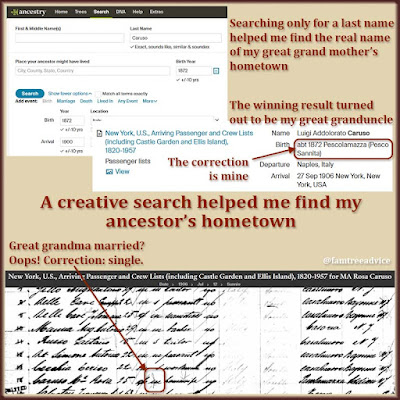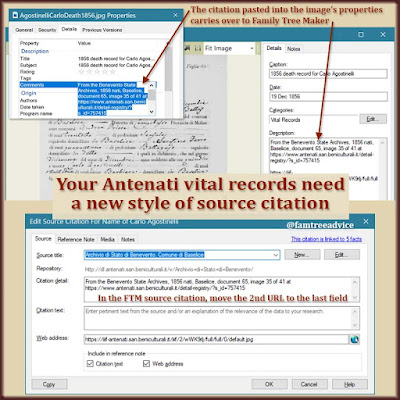If your ancestors lived in certain countries, you can find lots of records for your family tree. You may find census records, city directories, military records, ship manifests, and more. But what if your ancestors' countries don't have those records available? How can you build your family tree using only an incomplete set of vital records?
Welcome to my world. I have two sets of 1st great grandparents who emigrated to the U.S., and one set of 2nd great grandparents who came here. Everyone else stayed in Italy for centuries.
 |
| Commit to these 5 rules and you can build your family tree from vital records alone. |
With access to Italian vital records, I have documented facts for 415 of my direct ancestors. They're the ones with Ahnentafel numbers. My tree is still growing because I'm obsessed with my ancestral hometowns. I'm using vital records to find every relative of my direct ancestors. And I continue to expand each family because of all the intermarriage in their towns.
Let's take a look at 5 "must-do's" for building your family tree from vital records alone. These tips are not confined to Italian vital records!
1. You Must Start Close to Home
When I learned I could view Italian vital records at a Family History Center, I jumped at the chance. This was many years ago before these vital records came online at the Antenati Portal.
I started with the town of Baselice. I knew the names of my grandfather's parents, but nothing more. I had to start with them and begin putting families together. By the time I finished viewing all the vital records between 1809 and 1860, I'd added 15,000 people to my family tree. For complete details of this process, see "5 Steps to Grow Your Italian Family Tree".
2. You Must Understand the Local Marriage Customs
My 4th great grandparents, Gregorio and Apollonia, came from the town of Circello. In 1814 Gregorio and two of their young children died. My 3rd great grandfather Francesco, still a baby, was the only surviving child. What happened to Apollonia? I couldn't find a death record for her in Circello.
I thought about all I'd learned from viewing tons of Italian marriage records. If a spouse died and there were young children in the family, the surviving spouse needed to remarry. Apollonia was widow with a one-year-old baby. She had to remarry, right away.
To find out how I found Apollonia and learned her parents names, see "How I Tracked Down My 4th Great Grandmother's Parents".
3. You Must Look in the Margins
I hate that most of my ancestral hometowns have no available marriage or death records from 1861 to 1930. But there is one saving grace that can make up for this lack of records. Margin notes! Sometimes you'll find a note in the margin of your person's birth record that can tell you:
- Who they married, where and when
- Where and when they died
- That their father died in World War I, and more!
To learn about these and other facts to fill in the gaps, see "3 Types of Bonus Details on Italian Vital Records".
4. You Must Scan for More Details
I have lots of cases in my family tree where a baby is born shortly after their father died. Early on, I was overlooking one incredible detail on that birth record. The father's death record isn't available. But his date of death is often written at the bottom of his child's birth record.
In one of my towns, I don't have access to the matrimoni processetti (see "The Italian Genealogy Goldmine: Wedding Packets"). I was so upset when I realized they were missing. But there is a substitute! In this town, the marriage documents themselves contain tons of detail, including:
- the bride and groom's exact date of birth
- when and where their parents died
- when and where their grandfathers died
Don't miss out on these and other important information on vital records. See "10 Details Not to Miss on Italian Vital Records".
5. You Must See Past the Clerical Errors
I've found glaring errors in a set of marriage records many times. Those glorious wedding packets have birth records for the bride and groom. But then you go to your family tree and see the mistake. The birth record isn't for the bride. It's for her same-named older sister who died as a child. Or the grandfather's death record is for a completely different man with the same name.
You've got to consider each document with care and make sure everything adds up. You'll avoid all these errors if your family tree contains all the siblings in every family.
What other common errors must you look for? Read the details in "5 Common Mistakes on Vital Records".
Old-country vital records have more accurate details than a U.S. vital record for an immigrant. That can be because the family was in one place for centuries. Everyone in town knows who this person's parents were.
Keep your eyes open for the many nuances of vital records as described in this article. Then you'll be ready to squeeze out every last detail for your family tree.












